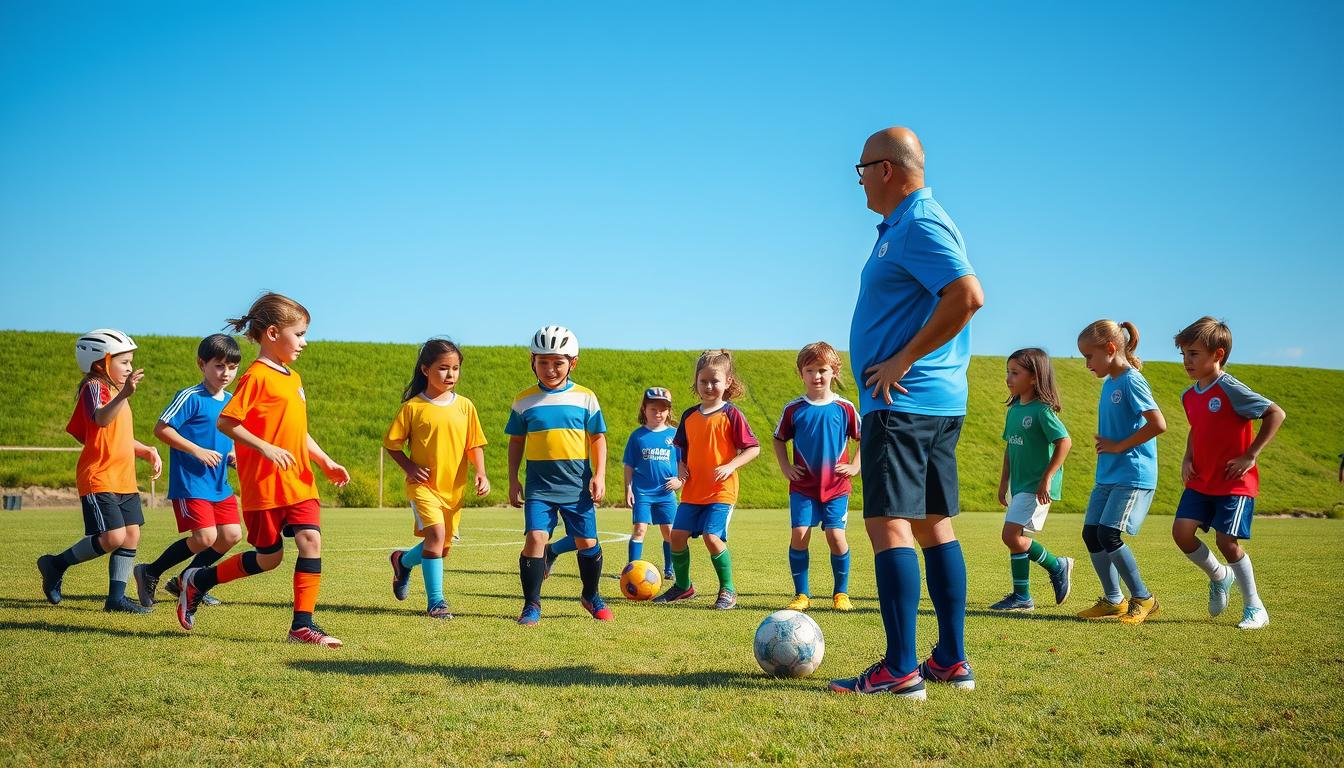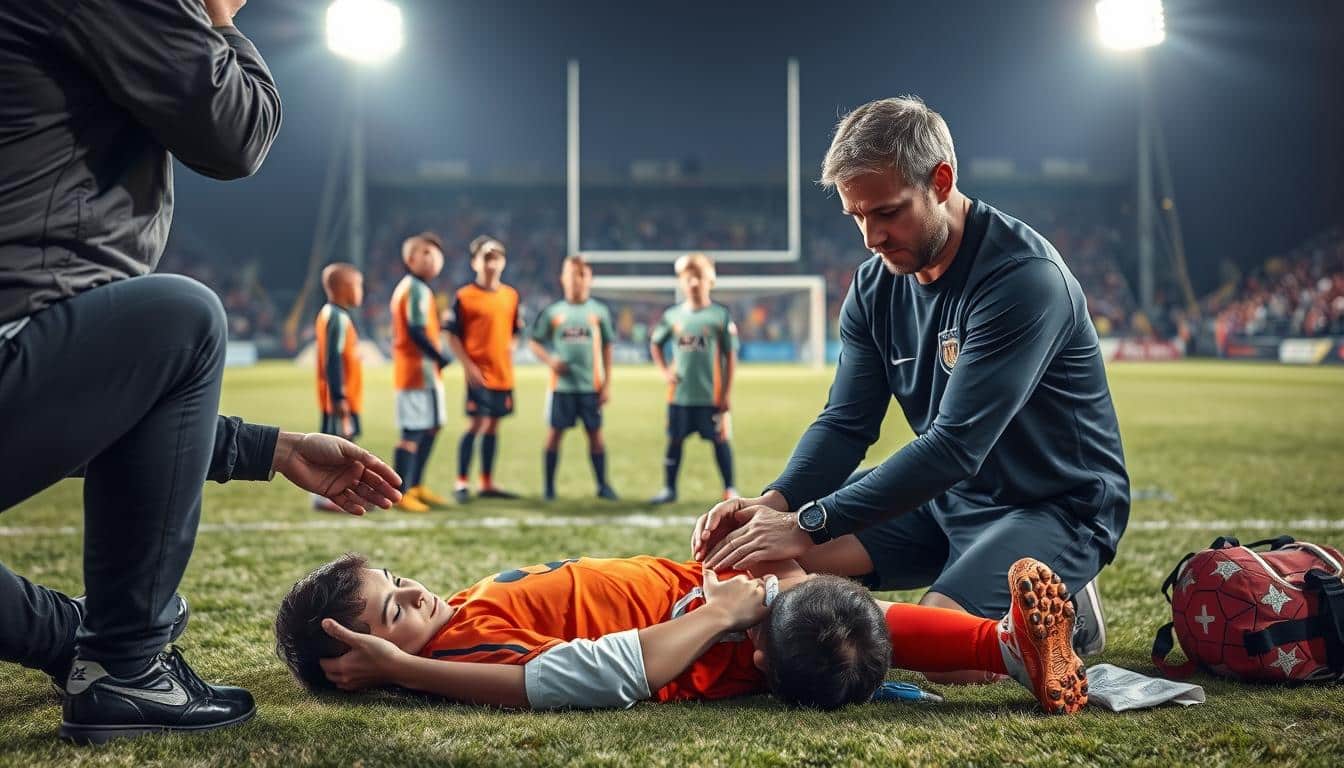Soccer Safety Tips for Kids: A Comprehensive Guide

Your child loves running across the field, chasing the ball, and scoring goals. But did you know that over 30% of youth sports injuries come from soccer? While the game builds teamwork and fitness, scrapes, sprains, and even concussions can happen. The good news: with the right steps, you can help them stay safe while having fun.
This guide isn’t about turning practice into a rulebook. It’s about balancing smart precautions with the joy of playing. From choosing the right shin guards to warming up properly, small changes make a big difference. You’ll learn how to spot early signs of overuse injuries and handle common mishaps quickly.
Key Takeaways
- Proper gear like shin guards reduces injury risks by up to 85%
- Warm-ups improve flexibility and prevent muscle strains
- Hydration and rest days combat overuse injuries
- Age-appropriate drills keep training safe and engaging
- Quick first aid responses minimize long-term damage
Getting Started with Soccer Safety Basics
Every young athlete deserves to enjoy the game while staying protected from common injuries. The right gear acts like a shield, letting players focus on skill-building instead of worrying about mishaps. Research from Nemours Alfred I. duPont Hospital for Children shows well-fitted cleats and shin guards reduce lower-leg injuries by 85% during matches.
The Importance of Proper Equipment
Ill-fitting shoes or loose shin guards create unnecessary risks. For example, cleats that pinch can cause blisters, while oversized guards slip during tackles. A study found 60% of ankle sprains occur when footwear lacks ankle support. Always check for snug (but not tight) fits and ASTM-certified materials.
| Equipment | Proper Fit | Risk Reduction |
|---|---|---|
| Cleats | 1/2 inch space at toes | 70% fewer slips |
| Shin Guards | Covers mid-shin to ankle | 85% less bruising |
| Socks | Moisture-wicking fabric | 50% lower blister risk |
Simple Safety Measures for Beginners
Start every session by inspecting gear. Replace worn laces and tighten guard straps. Teach players to speak up if something feels off—a loose cleat today could mean a twisted ankle tomorrow. Hydrate well and avoid sharing water bottles to prevent illness spread.
Finally, scan the field for debris before drills. A quick walk-through takes two minutes but prevents 90% of trip-related falls reported in youth leagues. Small steps build habits that last a lifetime.
Preparing Before the Game
Smart preparation turns potential risks into confident play. Start by arriving 20 minutes early to review the environment and equipment. This small time investment builds habits that protect young athletes during high-energy moments.
Field Inspection and Warm-Up Routines
Walk the playing area first. Remove rocks, holes, or debris—these cause 40% of trip-related sprains in youth leagues. Pair this with dynamic stretches to activate muscles. A study in the Journal of Sports Science shows proper warm-ups reduce strains by 65% compared to static stretching alone.
| Activity | Benefit | Time |
|---|---|---|
| High knees | Boosts circulation | 2 minutes |
| Side shuffles | Prevents groin strains | 90 seconds |
| Leg swings | Improves hip flexibility | 1 minute |
Healthy Habits That Prevent Injuries
Always double-check gear before stepping onto the field. Tighten shin guard straps and ensure cleats fit snugly—loose footwear accounts for 55% of ankle sprains. Hydrate with water or electrolyte drinks every 15 minutes to avoid cramps.
Encourage players to voice discomfort early. Addressing minor aches during warm-ups saves time and prevents common soccer injuries. These practices create a foundation for safer, more enjoyable games worldwide.
Soccer Safety Tips for Kids
Staying protected on the field involves more than just wearing gear—it’s about smart awareness and quick action. Let’s explore how to safeguard vulnerable areas like the head and joints while recognizing when the body needs a break.
Protecting Your Head and Limbs
Head injuries account for 15% of sports-related ER visits among young athletes. Always use approved headgear during practice if your league allows it. Teach players to avoid using their forehead for ball contact until they master proper technique. For knees and ankles, strengthen muscles with balance exercises like single-leg stands.
| Area | Common Risks | Prevention Steps |
|---|---|---|
| Head | Concussions from collisions | Limit heading drills under age 12 |
| Knee | ACL tears during pivots | Practice landing with bent knees |
| Ankle | Sprains from uneven terrain | Wear high-top cleats for support |
Check the ball’s condition before games. Overinflated or worn-out balls increase impact force during kicks. A simple bounce test helps—drop it from waist height; it should rebound to your knees.
Spotting Early Signs of Overuse Injuries
Persistent soreness after practice? That’s a red flag. Overuse issues like shin splints often start as mild discomfort. Watch for limping, swelling, or reluctance to play—these signal it’s time to rest.
Track activity levels weekly. Young athletes shouldn’t train more hours than their age (e.g., a 10-year-old caps at 10 hours). Mix sports to prevent repetitive strain on the same joints. When in doubt, consult a health professional.
Gear Guidelines for Safe Soccer Play
The right gear transforms every kick and sprint into a confident move while shielding young players from harm. It’s not just about wearing equipment—it’s choosing items that work with the body, not against it. Let’s break down how to pick and maintain key pieces for peak performance.
Selecting the Right Cleats and Shin Guards
Start with footwear. Molded cleats work best on firm, dry fields, while screw-in styles grip better on wet grass. Check the toe box—there should be a thumb’s width of space to prevent blisters during games. Pair them with shin guards that cover from below the knee to above the ankle. Velcro straps keep them secure without cutting circulation.
| Gear Type | Best For | Key Feature |
|---|---|---|
| Molded Cleats | Dry Fields | Even traction |
| Screw-In Cleats | Soft Terrain | Adjustable grip |
| Shin Guards | All Play | Hard plastic core |
Inspect gear before each practice. Look for worn studs, cracked guards, or frayed straps. A quick 2-minute check prevents 80% of equipment-related mishaps reported in youth leagues. Clean cleats with mild soap to maintain grip and dry guards thoroughly to avoid odor buildup.
Don’t forget hydration! Muscle cramps often stem from dehydration, not just overexertion. Use a parent’s guide to youth soccer equipment to find leak-proof water bottles that fit in gear bags. Proper care keeps players focused and reduces injury risks during critical game moments.
Safe Practices During the Game
Staying sharp during matches helps young athletes enjoy every moment while avoiding mishaps. Focus on active awareness and controlled movements—these habits build confidence and reduce collisions.
Staying Aware of Teammates and Opponents
Keep your head up to scan the field every 3-5 seconds. This simple habit cuts accidental collisions by 40% in youth leagues. Teach players to call out “man on!” when opponents approach from behind.
| Situation | Proper Response | Benefit |
|---|---|---|
| Corner kicks | Mark space, not just players | Reduces header clashes |
| Fast breaks | Check both shoulders | Avoids blindside contact |
| Loose balls | Bend knees, stay low | Prevents tripping hazards |
Using Proper Techniques to Reduce Injury Risk
Master side-foot passes instead of toe kicks—they’re 75% less likely to strain muscles. When tackling, lead with the foot’s instep and keep elbows tucked. Coaches report 60% fewer sprains when players follow these steps.
Make sure to rotate positions if you play multiple games weekly. This balances muscle use and lowers overuse injury risks. For minor scrapes, clean wounds immediately and apply sterile bandages—quick first aid stops infections before they start.
Remember: injury prevention works best when everyone participates. Encourage teammates to follow safe protocols like controlled slides and fair challenges. Small choices during play create lasting protection for growing athletes.
Handling Injuries and First Aid Steps
Quick response to injuries keeps young players smiling and safe on the field. Knowing what to look for—and how to act—can turn a scary moment into a manageable one. Let’s break down the essentials every parent and coach should know.

Recognizing Signs of Minor and Major Injuries
Minor issues like scrapes or muscle cramps often show redness, mild swelling, or complaints of “soreness.” Major concerns—think ankle knee twists or head impacts—may involve inability to bear weight, confusion, or visible deformity. Always ask injured children to describe pain levels and movement limits.
| Injury Type | Signs | Action Priority |
|---|---|---|
| Sprained Ankle | Swelling, tenderness | Apply ice, elevate |
| Head Impact | Dizziness, nausea | Seek medical help |
| Cuts | Bleeding, debris | Clean, bandage |
Immediate First Aid Actions for Safety
For minor injuries minor, follow RICE: Rest, Ice, Compression, Elevation. Use clean gauze for cuts and watch for infection signs. If a child can’t move a joint or complains of sharp pain, keep the area still and call for help.
Always have a stocked first aid kit with instant cold packs and elastic bandages. Trained responders should check concussions using the SCAT5 checklist. Remember: quick care helps reduce risk of complications and gets kids back to play faster.
Encourage leagues to keep emergency contacts visible and practice injury scenarios yearly. When in doubt, err on caution—it’s better to sit out one game than miss a whole season.
Wrapping Up and Staying Active Safely
The thrill of the game shines brightest when players feel protected and prepared. By choosing well-fitted cleats, warming up properly, and listening to your body, you create a foundation for endless fun. These steps aren’t restrictions—they’re tools that help you play stronger and longer.
Regular gear checks keep risks low. Inspect cleats for worn soles and secure shin guards before each match. Understanding common risks lets you avoid them, while proper hydration and rest days prevent overuse injuries. This balance helps you reach personal goals without setbacks.
Remember: safety measures unlock the full benefits of staying active. They protect your health while boosting confidence on the field. When safety comes first, achieving team and personal goals becomes more rewarding. Keep learning, stay aware, and enjoy every victory—big or small—that comes from playing smart and responsibly.
